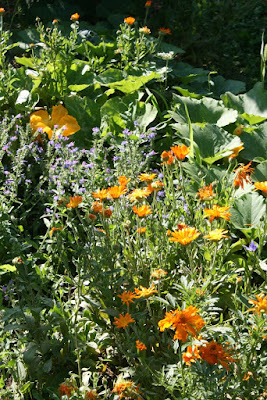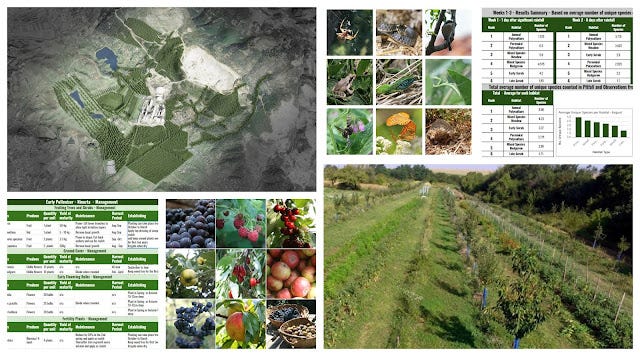During this post, we're going to take a look at a few of our favourite plants with edible flowers. Most of these species flowers also provide excellent forage for a wide range of pollinators, so don't eat all of them :)
We include the below species in all of our forest garden and polyculture landscapes and are always on the lookout for new species so please let us what your favourite edible flowers are in the comment section below.
Orange DayLily - Hemerocallis fulva
Famous for its beautiful orange flowers the Orange Daylily is adaptable, very tolerant of lots of different soil types, and highly attractive to a range of pollinators including butterflies. Daylily flowers last just one day, but each of the many stalks bears numerous flower buds, so the actual bloom time is much longer - more like weeks. The plants in our garden are really happy growing in the shade, creeping along the boundary wall of the property, making an ideal candidate for shady groundcover or a border. They are very hardy, and once established you should reliably have an annual harvest.
Overview: Hemerocallis fulva is a perennial growing to 1m at a medium rate and spreading via tuberous roots, making it an excellent ground cover plant on a boundary or semi-shady edge of a forest garden. USDA hardiness zone 5 - 10. The species is hermaphrodite and the plant is not self-fertile and the vibrant colour of the blooms attracts a range of beneficial organisms to the garden, including butterflies.
Edibility: PFAF website gives the plant a 5/5 edibility rating, listing the tubers and leaves as also being edible. Flowers can be eaten raw or cooked and their flavour has been described as a combination of asparagus and courgette. They make a nice garnish and given their relatively large size, maybe stuffed or made into fritters, much like the flower of the courgette plant. Medicinally, an extract of the flowers is used as a blood purifier. The flower buds taste pretty good too.
Where and When to Harvest: Orange Daylillies start flowering in mid June in our region and continue for a month or so. As the common name suggests, blooms only last a day, but flowers keep coming on multiple stems. Harvest the whole flower by snapping off at the base.
Top Tip: The pollen on the anthers provides a delicate floral flavour as well as having health benefits when eaten!
Want to learn more about Regenerative Landscape Design? Join The Bloom Room!
The Bloom Room is designed to create a space for more in-depth learning, for sharing projects and ideas, for seeking advice and discovering opportunities.
Ultimately, it aims to build a more intimate, interactive, and actionable relationship between members, a way for the Bloom Room community to support each other’s projects and learning journeys, and to encourage and facilitate the design, build, and management of more regenerative landscapes across our planet.
What you can expect as a member of the Bloom Room
As a member of the Bloom Room you can expect;
Access to an interactive forum where you can ask questions, direct what type of content you would like to see as well as share your own content and projects.
Live sessions featuring general Q&A and tutorials on design software for creating and presenting polycultures.
Full Access to all of the content on Substack
Future opportunities to join our Global Regenerative Landscape Design and Consultancy Service, with potential roles for those with the will and skill to join our design team.
An opportunity to take part in the group ownership of a Regenerative Landscape. You will find more details on that here.
Become a paid subscriber to our Substack to join. The annual subscription is currently $70 and the monthly subscription is $7 (monthly subscription excludes discounts for products and services) . You can join here, we look forward to meeting you!
Calendula- Calendula officinalis
(Calendula officinalis)--Calendula is a lovely, self-seeding annual native to Europe. It's often seen in cottage gardens and is fantastically appealing to a wide range of insects and other creatures, including lots of beneficial organisms. We've been growing it as part of our annual productive polyculture, Zeno, for some years now, and after the first couple of years have no longer needed to cultivate it from seed as it readily self-seeds.
Overview: Calendula is an annual plant growing to 0.6m in height at a medium rate. It is usually in flower from May right through until October and the seeds ripen from August to November. The species is monoecious and is pollinated by Bees. It's pretty tough and can grow in poorer quality soils, as well as being able to tolerate some drought. USDA hardiness zone 2 - 11.
Edibility: Listed on the
PFAF website as 3/5. They are nutrient-rich and often added to salads, giving them an exciting splash of color. The dried petals have a more concentrated flavour and are used as a seasoning in soups, cakes, and also for tea. Medicinally, Calendula has a good reputation for healing skin ailments.
Where and When to Harvest: The flowers can be harvested as soon as they start to appear, usually in May/June. The bloom time is very long, sometimes as much as 6 months, so there's no need to rush :) We usually leave some flowers on each plant for other visiting organisms, but the more you pick, the more prolifically the plant flowers. The blooms are easily harvested using a traditional deadheading method.
Top Tip: Sometimes used as a poor man's saffron, try drying the petals and crumbling into a fine powder to spice up dishes.
Welcome to our Online Store where you can find Forest Garden/ Permaculture plants, seeds, bulbs and Polyculture multi-packs along with digital goods and services such as Online Courses, Webinars, eBooks, and Online Consultancy. We hope you enjoy the store and find something you like :) It's your purchases that keep our Project going. Yuu can also find our full list of trees. shrubs and herbs for forest gardens on our website here
Purple Coneflower - Echinacea purpurea
Echinacea is a spectacular herbaceous perennial attracting bees and butterflies while in bloom. If the cones are left intact in winter, birds dine on the seeds. A very easy to grow plant, tolerant of drought, heat, humidity, and poor soils. The plant is famous for its medicinal properties, a very popular herb, especially for the treatment of flu and colds.
Overview: Echinacea is a herbaceous perennial growing to 1.2m at a medium rate. It is in flower from July to August and is is hermaphroditic, attracting a variety of pollinators to its blooms. Clumps can be divided when they become overcrowded (about every 4 years) and if some of the seed heads are left in place it self seeds. USDA hardiness zone 2 - 10.
Edibility: Listed on the
PFAF website as 1/5 without much information other than the leaves can be eaten, however, plenty of other sources online site the petals of the flowers as being edible. Excellent for brightening up a salad or a tasteful garnish on a desert. I'm not sure the spiny central cone would make for pleasant eating anyway :) Excellent reputation medicinally as an immune system booster. Typically seen as a tea.
 |
| Echinacea purpurea and Crab Spider - Thomisidae |
Where and When to Harvest: Flowers typically bloom in late summer. Snip off the whole flower heads and pick the petals off for use in the kitchen.
Top Tip: If harvesting for tea, consider snipping a whole flower stem just above a node to also gather some leaves, which may also be added to the flowers for tea.
Rose of Sharon - Hibiscus syriacus
Rose of Sharon more often referred to as simply Hibiscus is a beautiful shrub, that takes well to pruning and can be used as a very pretty hedge or a stand-alone ornamental. Flowers start to bloom in August and September and will continue to flower right up until early October in our region. It's a very easy plant to care for and attracts a wide range of beneficial organisms.

Overview: Hibiscus is a multi stemmed deciduous shrub or small tree growing to 3m in height at a medium rate. It flowers in the late summer through to early autumn bringing a bit of tropical beauty to more temperate climates just when we think it's all over :) Can tolerate most soil types and succeeds in semi shade. USDA hardiness zone 5 - 9.
.
Edibility: Listed on the
PFAF website as 4/5. Can be eaten raw or cooker. A mild flavour and mucilaginous texture, they are delightful in salads, both for looking at and for eating. Apparently
Hibiscus flowers Enchiladas are amazing and used inside the enchiladas in place of meat. We'll give it a go this year. May also be dried for tea. Multiple medicinal uses.
Where and When to Harvest: Harvest the Hibiscus flowers when in full bloom by plucking off the tree and removing the calyx — the bulb-like part of the plant between the flower and the stem.
Top Tip: Hibiscus makes a great addition to iced tea!
***Take Care when Eating Wild Plants and Plants you are not familiar with***
Although these plants have been used for decades in the kitchen by some, as with any plants we consume, it's worth doing your own research first. For example, there are some reports of toxicity with other parts of certain plants, and some people may experience an adverse reaction while many people report no issues at all.
Want to learn how to design, build and manage regenerative landscapes? Join us on our Regenerative Landscape Design - Online Interactive Course. We look forward to providing you with the confidence, inspiration, and opportunity to design, build and manage regenerative landscapes, gardens, and farms that produce food and other resources for humans while enhancing biodiversity.
You can access the course material at anytime and join the live sessions and interactive forums that run from May - Oct every year. All members of the Bloom Room receive a 500 EUR discount. To take up this offer all you have to do is become an annual subscribers to our Substack and register here with the promo code BLOOM.
I look forward to you joining !
Some more Plants with Edible Flowers
Here are a few more of our favourite plants with edible flowers:
 |
| Plants with Edible Flowers |
Allium spp.
It would be a crime to not mention Allium spp. here seeing as all of the plants in this genus have very tasty edible flowers, if you're into the taste of garlic that is.
Support Our Project
If you appreciate the work we are doing you can show your support in several ways.














Nice. I will try to grow some Sharon hedges in the homegarden
ReplyDeleteThx
This comment has been removed by a blog administrator.
ReplyDelete